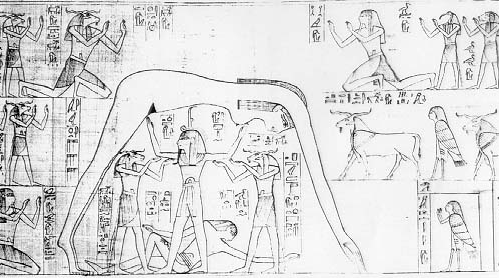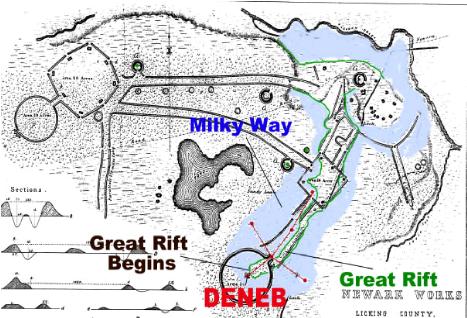 | ||
Above: Traditional Egyptian depiction of Nut. | ||
Cygnus: From The Pyramids of Egypt to the Newark, Ohio Earthworks By Dr. Greg Little In past months, three articles on the connection between the Cygnus constellation and the three pyramids at Giza have been presented in Alternate Perceptions. As Andrew Collins suggested in his 2006 book, The Cygnus Mystery, the three pyramids at Giza appear to have been constructed to represent the cross band stars of Cygnus, rather than Orion’s Belt. In addition, in the night sky of 2600 B.C. Cygnus rose on a NE alignment from Giza and set on a NW alignment. Finally, one of the other stars of Cygnus falls on the sacred hill of Gebel Ghibili, near a well opening, which is located in the same vicinity. This well is found in the area indicated by the readings of the “Sleeping Prophet,” Edgar Cayce, as the entrance to the Hall of Records. In The Cygnus Mystery, Collins goes into great detail on the probable role of Cygnus in Egyptian mythology and astronomy, but only one important point is relevant to the discussion here. In the Heliopolis myth of creation, a sky goddess named Nut was created along with a twin brother Geb. Typical Egyptian depictions of Nut show her arched across the sky symbolizing the lower constellations of the Northern sky. In brief, Nut symbolized the Milky Way and its important stars, and the souls of the dead were carried through this band of stars to a specific location in it by a bird. Collins presented evidence from archaeoastronomers that indicated Cygnus—located in the Great Rift of the Milky Way— was placed at the junction of Nut’s thighs, serving as a birth canal for souls—and the sun. The nightly circular movement of Cygnus from the NE to the NW symbolized the daily rising of the sun from and into Nut’s body. As Collins writes, “Nut can be viewed as the personification of the Milky Way, which when ‘seen in its entirety over the course of the year, has the appearance of a female…’” Collins has also shown how a host of other ancient cultures around the world venerated Cygnus as the portal to heaven. These ancient cultures are found in Asia, Europe, and the Middle East. However, the possibility that the beliefs about Cygnus may have been carried to the Americas by the earliest inhabitants there led Collins to investigate first-hand if Cygnus was somehow involved in America’s Mound Builders. He turned his attention to what many people consider to be the most mysterious ancient earthworks in the entire world. This spot, strangely unknown to many people, can be found partly intact in present day Newark, Ohio. | ||
 | ||
Above: 1848 survey of the Newark, Ohio earthworks. In the upper left side is the Circle and Octagon. The Great Circle in near the bottom, just right of the center. The bird effigy mound is in the center of the Great Circle. | ||
The Newark, Ohio Earthworks The Newark site dwarfs every other mound complex in the Americas. It was constructed by what American archaeologists term the Hopewell Culture between 500 B.C.-100 B.C. The above survey of the site shows the main formation, however, one set of parallel walls extended to the south an astonishing 56 miles to Chillicothe, Ohio where similar constructions can be found. A curious earthen embankment on the western side (left), constructed by walls of earth piled from 6 to 20 feet high, formed a perfect circle attached to an octagon. The circle enclosed 20 acres while the octagon enclosed 50 acres. Inside the octagon are 8 truncated earthen pyramids at each corner. This intact formation has now been shown to have been utilized to precisely calculate the movements of the moon over 18.61 years, in essence serving as a functional eclipse calculator. From the Circle-Octagon site, three parallel sets of walls formed walkways. They were all 175 feet wide, formed by earthen walls 3-feet or more high. As we wrote in Mound Builders (2001), “The northernmost walkway led a mile east to a complex set of mounds, embankments, and circles that defy description. The center walkway also extended east to a 20-acre embankment in the form of a square. To the southeast from the square, more embankments led to a gigantic, 30-acre circular earthwork with a single opening pointing to the northeast. The circle, generally known as the ‘Great Fairgrounds Circle,’ was formed by an outer wall 9-feet tall. A moat, 7-feet deep, ran inside the wall, creating a 16-foot high, continuous interior wall.” As should be obvious after studying the survey of the immense Newark site, that the function of this complex remains one of the greatest mysteries in American archaeology. Collins Findings At Newark Because of the similarity of the Great Circle to the circular Avebury site in England, Collins focused his work at Newark on this structure. The earthwork and stone circle of Avebury is virtually identical in size to the Great Circle at Newark and both have a similar outer embankment and moat. This is an amazing coincidence, if it actually is nothing but a coincidence. In the exact center of the Great Circle at Newark is an effigy mound long thought to be formed in the shape of a bird. Collins could see the similarity of the mound to a bird, but it seemed to more symbolize a bird’s foot. In Native American culture, the bird’s foot represented the Northern Cross, the main stars forming the cross portion of the constellation of Cygnus. Interestingly, the effigy mound is carefully oriented toward the only opening of the circle—to the NE. In addition, excavations at Newark have shown that funerary rites took place at the effigy mound, evidenced by many charred bones found under its surface. Utilizing a computer astronomy program, Collins ran the data from the Newark site back to 100 B.C., the time that Newark was at its height. He found that two hours before sunrise at the midsummer, the Milky Way stood straight up as viewed from the top of the effigy mound toward the only opening. Following the Milky Way to the center of the sky—directly overhead of the bird effigy mound, was Cygnus. I later obtained the same results using a different astronomy program. Confirming this finding was information Collins gathered after visiting Newark. He found that archaeologists had already suggested that the bird effigy at Newark was a representation of Cygnus, although precisely what that meant in terms of their rituals and earthwork alignments at the site wasn’t clear to them. Native American cultures, as did Egyptians and others, saw the Milky Way as a “river of souls,” the spirit path leading departing souls from earth back to their origin. The things that are accepted by archaeologists regarding the Hopewell funeral rites is that they believed it necessary to destroy the physical body to release a soul so it could return to the spirit path. In addition, these ancient people held the belief that spirits could only travel on a straight line meaning that earthen walls could channel the spirit in specific directions. The essence of what Collins found at Newark has several implications. First, the utilization of the bird mound as a crematory meant that it was used as the final point where the spirit was released from the physical body. Once released, the spirit was propelled through the only opening in the enclosure, toward the NE, toward the bottom of the Milky Way. Following the pathways outside the Great Circle through various embankments may well have served as a means of physically moving the spirit through the Milky Way, ultimately coming to the final portal into heaven—Cygnus. Following this idea, I superimposed Cygnus and the Milky Way over the Newark site in various ways. Although several methods seem to fit, in general, the one that seems to fit best is shown in an accompanying illustration. The Great Rift in the Milky Way as well as other important stars and the overall shape of the Milky Way conform to the basic layout of the site. While I believe that propelling the soul back to the Milky Way and ultimately to Cygnus appears to have been the function of this incredible structure, precisely how the formation represents the Milky Way remains unclear if indeed this was its function. Nevertheless, Collins’ work has shown that the Great Circle was, indeed, focused directly on Cygnus. Finally, what Collins has shown implies that Cygnus was universally seen as the portal to the heavens and that this belief was spread across all ancient cultures. | ||
 | ||
Above: If the complex linear and circular earthworks at Newark were constructed to represent Cygnus and the Milky Way, this is one way that it could fit the site. The bird mound woud be Deneb and the Great Rift of the Milky Way would funnel through the opening to the NE. The general outline of the Milky Way is shown in light blue with the inside of the Great Rift lined in green. The major reason that this alignment seemed most appropriate was that several other bright stars fit on important circular formations at the site. A ritual of carrying the body of the dead down through the pathways into the Great Circle may have been performed. At the bird mound, the body would have been cremated, releasing the spirit to move up to the Milky Way and ultimately to Cygnus. Nevertheless, it is important to note that there are other ways that Cygnus may fit this complex. | ||
 | ||||
 | ||||
The Illustrated Encyclopedia of Native American Mounds & Earthworks — by Dr. Greg Little | ||